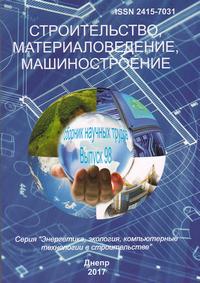Numerical simulation of air pollution in workplaces after toxic chemical emission
Keywords:
atmosphere pollution, numerical simulation, accident emission of toxic chemicalAbstract
Purpose. Development of a numerical model to compute the dynamics of atmosphere pollution in workplaces after accidents which results in toxic chemical emission. Methodology. For the numerical simulation of atmosphere pollution in workplaces 3D equation of pollutant dispersion is used. This equation takes into account the convective and dispersion processes of pollutant transport, the rate of toxic chemical emission, position of source emission. For the numerical integration of the governing equation of pollutant dispersion in atmosphere the implicit finite-difference scheme is used. On the basis of the numerical model generic model was developed. FORTRAN language was used to develop the generic model. Computational experiments were carried out to calculate the dynamics of pollution after accident emission at ammonia pipeline which is situated at Dnepr River. Findings. The proposed model allows to simulate the atmosphere pollution in workplaces after accident emission of toxic chemicals. The model allows quickly obtain the information which can be used for response methods development. Results of numerical experiments are presented. Originality. 3D numerical model was developed allowing to calculate quickly atmosphere pollution after accidents which result in toxic chemical emission. Practical value. The developed model can be used for numerical simulation of air pollution in workplaces after toxic chemicals emissions. It can be used at the stage of PLAS (ПЛАС) development.References
Belyaev N.N., Berlov A.V., Mashikhina P.B. Modelirovanie nestacionarnyh processov avarijnogo zagryazneniya atmosfery [Simulation of non-stationary processes of emergency air pollution]. Dnepropetrovsk, Aktsent PP Publ., 2014, 127 p.
Belyaev N.N., Gunko E.Yu., Rostochilo N.V. Zashhita zdaniy ot proniknoveniya v nih opasnyh veshhestv monografiya [Protection of buildings from the penetration of dangerous substances into them: monograph]. Dnepropetrovsk, Aktsent PP Publ., 2013, 136 p.
Belyaev N.N., Muntyan L.Ya. Ekspress metod otsenki potentsialnogo territorialnogo riska pri avariyah na transporte [Express method for assessing potential territorial risk in case of transport accidents]. Vіsnyk Dnіpropetrovskoho natsionalnoho universytetu zalіznychnoho transportu іmeni akademika V. Lazaryana [Bulletin of the Dnipropetrovsk National University of Railway Transport named after Academician V. Lazaryan]. Nauka ta prohres transport – Science and Transport Progress, 2016, no. 1 (57), pp. 32-36.
Bruyatskiy Ye.V. Teoriya atmosfernoy diffuzii radioaktivnykh vybrosov [The theory of atmospheric diffusion of radioactive emissions]. Kiev, Institut gidromekhaniki NAN Ukrainy Publ., 2000. 443 p.
Gusev N.G., Belyaev V.A. Radioaktivnye vybrosy v biosfere [Radioactive emissions in the biosphere]. Moscow, Energoatomizdat Publ., 1991. 257 p.
Biliaiev, M. Numerical Simulation of Indoor Air Pollution and Atmosphere Pollution for Regions Having Complex Topography / M. Biliaiev // NATO Science for Peace and Security Series C: Environmental Security. – 2012. – P. 87–91. doi: 10.1007/978-94-007-1359-8_15.
Hanna S. Air Quality Modelling over. Short Distances. College on Atmospheric Boundary Layer and Air Pollution Modelling. – 16 May–3 June, 1994. – № SMR/760–2 – P. 712–743.
Maria de Lurdes Dinis. Simulation of liberation and dispersion of radon from a waste disposal // Maria de Lurdes Dinis, Antonia Fluza. Advances in Air Pollution Modeling for Environment Security. NATO Science Series, Springer. – 2004. – Vol. 54. – P.133–142.
Biliaiev M.M., Kharitonov M.M., Amelina L.V. Numerical simulation of the atmosphere pollution after accident at the “Tolliaty-Odessa” ammonia pipe / M.M. Biliaiev, M.M. Kharitonov, L.V. Amelina // NATO Science for peace and security series C: Environmental security; Air pollution modeling and its application XXII, 2014. – pp. 391-395.
Dispersion Modeling of Hydrogen Sulfide at Cimarex Rands Butte Project Using ALOHA. Bureau of Land Management Pinedale Field Office. SWCA Environmental Consultants 1043 Coffeen Avenue, Suite D Sheridan, Wyoming 82801. January 2010. – 26 p. www.swca.com.
Vasiliy V. Popovich, Manfred Schrenk, Christophe Claramunt, Kyrill V. Korolenko (Eds.). Information Fusion and Geographic Information Systems. Lecture Notes in Geoinformation and Cartography. Proceedings of the Fourth International Workshop, 17-20 May 2009. – 371 p.
Warner T., and Coauthors. The Pentagon SHIELD field program: Toward critical infrastructure protection. Bulletin of the American Meteorological Society, doi:10.1175/BAMS-88-2-167, 2007.
Downloads
Published
Issue
Section
License
Редакція Видання категорично засуджує прояви плагіату в статтях та вживає всіх можливих заходів для його недопущення. Плагіат розглядається як форма порушення авторських прав і наукової етики.
При виявлені у статті більш ніж 25% запозиченого тексту без відповідних посилань та використання лапок, стаття кваліфікується як така, що містить плагіат. У цьому випадку стаття більше не розглядається редакцією, а автор отримує перше попередження.
Автори, в статтях яких повторно виявлено плагіат, не зможуть публікуватися в усіх журналах Видавництва ДВНЗ «Придніпровська державна академія будівництва та архітектури».
Автори, які публікуються у цьому журналі, погоджуються з наступними умовами:
- Автори залишають за собою право на авторство своєї роботи та передають журналу право першої публікації цієї роботи на умовах ліцензії Creative Commons Attribution License, котра дозволяє іншим особам вільно розповсюджувати опубліковану роботу з обов'язковим посиланням на авторів оригінальної роботи та першу публікацію роботи у цьому журналі.
- Автори мають право укладати самостійні додаткові угоди щодо неексклюзивного розповсюдження роботи у тому вигляді, в якому вона була опублікована цим журналом (наприклад, розміщувати роботу в електронному сховищі установи або публікувати у складі монографії), за умови збереження посилання на першу публікацію роботи у цьому журналі.
- Політика журналу дозволяє і заохочує розміщення авторами в мережі Інтернет (наприклад, у сховищах установ або на особистих веб-сайтах) рукопису роботи, як до подання цього рукопису до редакції, так і під час його редакційного опрацювання, оскільки це сприяє виникненню продуктивної наукової дискусії та позитивно позначається на оперативності та динаміці цитування опублікованої роботи (див. The Effect of Open Access).

